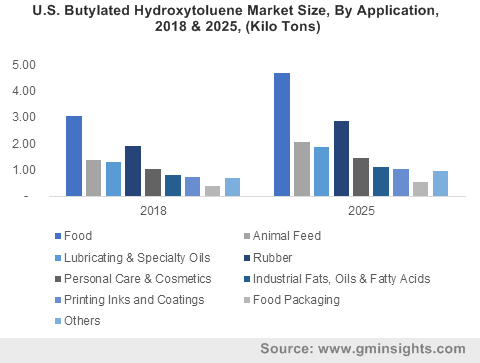APAC dibutylhydroxytoluene market to accrue remarkable proceeds from the personal care & cosmetics segment, food packaging application to boost the industry revenues over 2019-2025
Publisher : Fractovia | Published Date : 2019-05-24Request Sample
Rising disposable incomes worldwide have certainly fueled the demand for numerous consumer products, stimulating the dibutylhydroxytoluene market growth over the past few years. Dibutylhydroxytoluene has been extensively preferred as an antioxidant in food, cosmetics and livestock feed, in addition to being a suitable additive for lubricants, printing inks and rubber products. Steady expansion of the food packaging, automobile and personal care segments will subsequently elevate the dibutylhydroxytoluene industry prospects globally. Fast-paced industrial development, combined with an upsurge in purchasing power of emerging economies, will lead to increased affinity for packaged food and make-up products in the Asia-Pacific (APAC) region.
U.S. Butylated Hydroxytoluene Market Size, By Application, 2018 & 2025, (Kilo Tons)

Essentially, APAC comprises of not only the two most populated nations in the world, but also several smaller countries with high population density which are experiencing a remarkable economic progress. Besides domestic businesses, various global brands have successfully penetrated these markets to meet the evolving consumer needs and provide a broader range of choices, including those offering cosmetics and self-grooming products.
An overview of the Asia-Pacific dibutylhydroxytoluene market in terms of the application spectrum
Personal Care & Cosmetics
The APAC region seemingly promises to be a leading revenue source for the dibutylhydroxytoluene market owing to an enormous customer base for skin and personal care offerings. Reportedly, adding dibutylhydroxytoluene in cosmetics prevents or slows down the deterioration of products like eye liners, lipsticks, face powders, moisturizers and skin care solutions by functioning as an antioxidant.
According to the National Bureau of Statistics of China, the cosmetics sector in the country had registered total retail sales of more than RMB 260 billion (US$37.6 billion) in 2018, displaying the immense potential for the dibutylhydroxytoluene market in the region. Further, it is estimated that Asian countries, led by China, contributed the most towards the import of beauty cosmetics and skin care products in 2018, with Hong Kong and Singapore also counted amongst the top five importers worldwide. The changing lifestyle in other nations such as India, Indonesia and Malaysia will boost local production of personal care products and cosmetics along with creating additional opportunities for imports, opening lucrative business avenues for dibutylhydroxytoluene suppliers.
Food Packaging
In recent years, the consumption of packaged food, drinks, snacks and cereals in APAC has seen an unpreceded growth rate, generating tremendous profits for food producers as well as related industry verticals. While the use of dibutylhydroxytoluene in food applications has often been subject to distinct opinions, the dibutylhydroxytoluene market has garnered substantial momentum from the need for reliable antioxidant packaging materials. These products impede the effects of lipid oxidation and extend the shelf life of products without deploying harmful preservatives in the food itself. dibutylhydroxytoluene helps fulfill the antioxidant requirement and can be incorporated into aesthetically appealing food packages and plastics that improve a product’s overall marketability.
Cereals have eventually become an important breakfast option all over the globe and the APAC region has witnessed accelerated growth in the niche segment. In fact, it was reported that in 2017 the Australian cereal industry itself was valued at over $1.2 billion annually. Moreover, a wide variety of snacks are available in convenience stores, supermarkets and fast-food outlets which consumers prefer to buy instead of preparing complete meals. With the population in Asia projected to reach over 4.77 billion by 2025, increased consumption of snacks across the region will result in considerable propagation of antioxidant food packaging materials, indicating significant demand potential for the regional dibutylhydroxytoluene market.
All in all, rapid proliferation of the cosmetics & personal care segment and consistent demand for packaged food products will invariably drive the expansion of the Asia-Pacific dibutylhydroxytoluene market. The global industry is constituted of key players including Kemin Industries, KH Chemicals, Eastman Chemical Co., Sasol, Sinofi Ingredients and OXIRIS, who strive towards developing innovative products and serve a myriad of application segments.